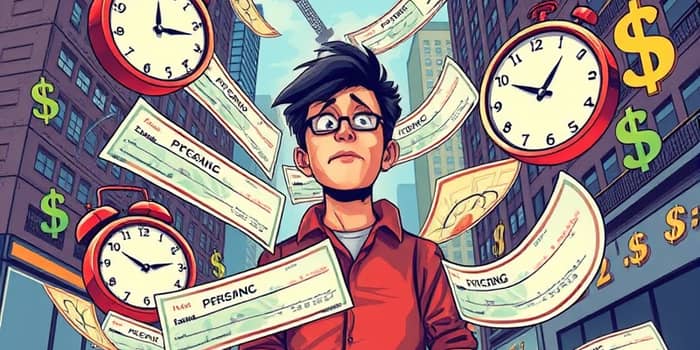When unexpected expenses arise, a payday loan can appear to be a fast and simple solution. With approval in minutes, these short-term credits promise relief until the next paycheck lands.
Yet beneath that convenience lies a complex web of fees, deadlines, and potential traps. Understanding the mechanics and hidden costs of these loans is essential to making informed choices and protecting your financial health.
Defining Payday Loans
At its core, a payday loan is a small high-cost short-term loans designed to bridge a cash gap until your next payday. Typically capped at $500 or less, it requires minimal paperwork and often skips any credit check.
Borrowers provide a lender with a post-dated check or authorize an electronic withdrawal for the full amount of the loan plus fees. The repayment date is tied to your next income deposit, usually within two to four weeks.
How Payday Loans Work
Obtaining funds is straightforward: visit a storefront or complete an online application. Once approved, you receive cash, a paper check, or an electronic deposit into your account.
To secure repayment, lenders rely on automatic bank account withdrawals. If your account has insufficient funds, the lender may repeatedly attempt to collect, leading to overdraft fees and additional charges.
This model prioritizes speed and convenience over affordability, making payday lending a last-resort option for many facing urgent financial needs.
The True Cost: Fees and Interest
Payday loans carry fees ranging from $10 to $15 for every $100 borrowed. When translated into an annual percentage rate, these costs skyrocket to nearly 400% APR, dwarfing traditional credit card and personal loan rates.
For example, borrowing $100 for two weeks with a $15 finance fee equates to a 390% APR if extended over a year. While a short-term fee may seem modest, repeated borrowing and rollover fees compound quickly.
Risks and Downsides
Though payday loans offer quick cash, they carry significant pitfalls that can derail your finances in the long run. Borrowers often find themselves trapped in a cycle of debt, paying more in fees than the original loan amount.
- Debt cycle and rollovers: Many borrowers end up reborrowing repeatedly, rolling over unpaid loan balances and accumulating escalating fees.
- Bank account access: Lenders initiate constant withdrawal attempts and fees, triggering overdraft charges and further financial strain.
- Aggressive collections: Missed payments can lead to persistent phone calls, legal notices, and stress for you and your family.
- High APR compared to alternatives: With rates approaching 400%, these loans are far more expensive than credit cards or personal lines of credit.
Regulatory Landscape and Economic Impact
The regulatory environment for payday loans varies widely by state. Some jurisdictions ban these loans outright, while others impose strict caps on fees, loan amounts, and collection practices.
Federal regulations now limit lenders to two unsuccessful withdrawal attempts before requiring borrower permission. However, this protection often arrives after the initial damage is done.
In 2022, payday lenders collected over $2.4 billion in fees across 30 states, with more than 20 million loans issued totaling nearly $8.6 billion in principal. The burden falls disproportionately on low-income households, many of whom become repeat borrowers and sustain a persistent debt trap.
Alternatives to Payday Loans
Before resorting to a payday loan, consider exploring other options that may carry lower costs and less risk.
- Borrow from family or friends: A zero- or low-interest loan can provide temporary relief without exorbitant fees.
- Credit union or community loan: Credit unions often offer small-dollar loans with reasonable interest rates and flexible terms.
- Employer-based advances: Some employers provide paycheck advances or salary loans with minimal fees and transparent terms.
- Nonprofit assistance programs: Community organizations and charities may offer grants, budgeting support, or short-term interest-free loans.
Conclusion: Empowering Your Financial Future
Payday loans may seem like a swift solution in a pinch, but the hidden costs and risks can lead to a cycle that’s hard to break. By understanding how these loans work and recognizing the true burden of high fees, you can make informed decisions that protect your financial well-being.
Reach out to credit unions, community groups, or trusted contacts before taking on high-cost debt. With careful planning, budgeting, and the right support, you can avoid the debt trap and take control of your finances for a more stable and secure future.
References
- https://www.consumerfinance.gov/ask-cfpb/what-is-a-payday-loan-en-1567/
- https://www.experian.com/blogs/ask-experian/how-payday-loans-work/
- https://en.wikipedia.org/wiki/Payday_loan
- https://www.investopedia.com/terms/p/payday-loans.asp
- https://www.responsiblelending.org/research-publication/down-drain-payday-lenders-take-24-billion-fees-borrowers-one-year
- https://www.debt.org/credit/payday-lenders/
- https://bettermoneyhabits.bankofamerica.com/en/debt/what-is-a-payday-loan










